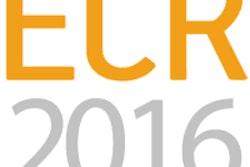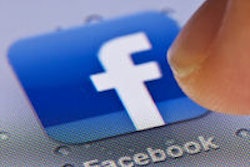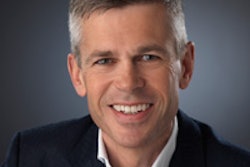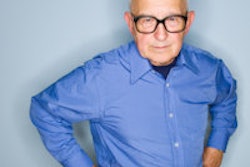
Social media represents a game-changing tool for improving patient care, supporting education, and enhancing visibility, but imaging professionals must be aware of the potential pitfalls and be trained in how to use it both effectively and safely. That's the view of Dr. Erik Ranschaert, staff radiologist at the Jeroen Bosch teaching hospital, s-Hertogenbosch, the Netherlands.
National and international radiology societies, including the European Society of Radiology (ESR) and RSNA, have now realized how important social media is to improve engagement of congress attendees. In addition, they are leveraging this technique to improve congress participation. ESR now has more than 160,000 Facebook members, many of them coming from Asia, and this figure is nearly three times the number of its actual members.
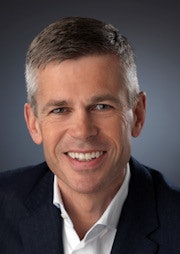 Radiologists must learn how to use social media correctly, said Dr. Erik Ranschaert.
Radiologists must learn how to use social media correctly, said Dr. Erik Ranschaert.A study from the MedData Group in 2014 on how doctors use social media revealed that 56% use it professionally, the majority to keep up with the latest developments in their own discipline and to exchange with peers. Other reasons include marketing their practice and establishing themselves as thought leaders. Nevertheless, common concerns remain patient and personal privacy, questions of liability, and finding time to fully engage with social media.
Twitter can solve the problem of too little time, but privacy issues are an ongoing consideration despite guidelines from professional groups such as the American Medical Association (AMA) and the Dutch Federation of Doctors, KNMG.
Key to professional integrity -- and avoiding prosecution -- is identity separation; doctors using Facebook [FB], for example, should limit public access to their personal pages. Similarly, privacy settings should be adjusted depending on the nature of a post, whether for a closed circle of colleagues about specific cases, or for general subjects destined for nonmedical friends.
"Privacy settings are important as they determine who can see what I post. Doctors should determine what is appropriate," said Ranschaert, who addressed social media trends in radiology and how the radiologist can use social media in daily practice, in two presentations at last week's Update in Medical Imaging congress, held in Bruges, Belgium.
','dvPres', 'clsTopBtn', 'true' );" >
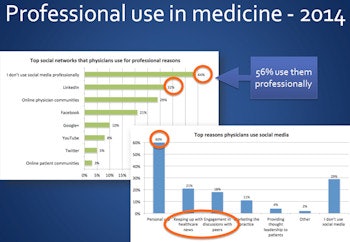
Click image to enlarge.
Source: 2014 report from MedData Group. All figures courtesy of Dr. Erik Ranschaert.
"It is so easy to track private individuals and link them to their professional profiles that doctors should be careful to limit access to their personal webspace," he said. "Online action and content posted may potentially damage reputations or even end careers so doctors need to learn how to clearly draw the barrier between private and professional life."
According to a 2012 PowerDMS study published on Pinterest, 87% of doctors accessed social media sites for personal use. Specifically, 61% of doctors questioned used FB in a personal capacity, and one-third of these reported receiving patient friend invitations.
"As it is cumbersome to always get the balance right using privacy settings, the best solution in my opinion is to make a separate professional and personal FB page or to keep FB personal and other sites professional, for example," he noted.
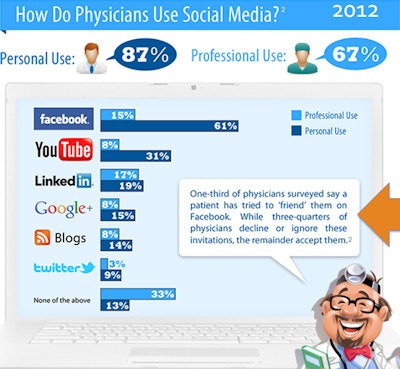 PowerDMS study on how physicians use social media.
PowerDMS study on how physicians use social media.Furthermore, even when exchanging with colleagues, confidentiality and patient privacy should be at the forefront of the radiologist's mind when posting.
"The CT image of the Brazilian footballer Neymar Jr.'s lumbar spine fracture, which in the event turned out to be a hoax, nevertheless went viral, highlighting several issues -- can radiologists trust the source? Is the data anonymized? And do they have permission from the patient to post an image?" Ranschaert said.
Social media sites have grown exponentially since 2006, with 74% of all online adults using them. Like doctors, patients access them for a number of reasons. In the same study, 30% used such sites to support them with healthcare problems, while 15% to 16% used them to review doctors. There was also a tendency to trust the information that doctors provided on the Internet, which radiologists need to be aware of when posting, according to Ranschaert.
Furthermore, radiologists need to keep abreast of new applications of social media in daily practice to fully exploit it. This list of applications is growing, according to Ranschaert, who pointed to scientific networking through sites like ResearchGate and BiomedExperts, and the sharing of documents (or "social bookmarking") through sites such as Pinterest.
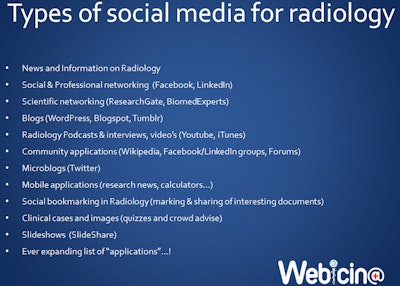 Types of social media.
Types of social media."The advantage is that it makes radiologists more visible as they gain direct access to patients, which helps to dispel the old stereotype of the remote radiologist sitting in the dark," he noted. "In this way it is a great equalizer among the disciplines and this 'collective brain' can provide radiologists -- and patients -- with many opportunities."
One application is crowdsourcing for medical information, as exemplified by Crowdmed, a tool developed in California through which patients can publish symptoms as well as reports and medical images, and invite doctors to solve their problem, while sophisticated algorithms will also generate the most likely diagnosis.
"Any radiologist can participate in this type of out-loud public thinking and we shouldn't ignore such an important patient-driven tool. Instead, we need to reflect on these new ways of interacting with patients and colleagues. For applications like CrowdMed, we need to establish added value and cost-effectiveness," he said.
With the development of Web 2.0, the capacity to create and exchange user-generated information over the World Wide Web has revolutionized communication between organizations and individuals. Forums, discussion groups, blogs, and social networks have largely replaced traditional electronic communication. In the medical domain, exciting new applications of social media are making healthcare increasingly participatory and patient-friendly, while patients and doctors share increasing volumes of personal and professional data through social media sites such as FB, LinkedIn, and Twitter.
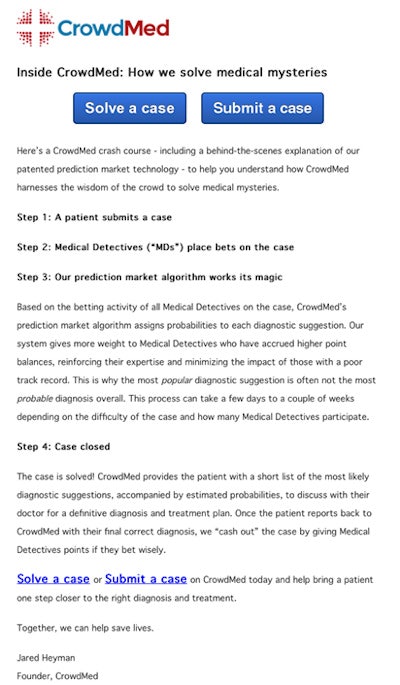 Inside Crowdmed.
Inside Crowdmed.Ranschaert also points to the expansion of electronic files available online to the patient that is starting to raise other questions such as how reports should be written.
"In Belgium, radiology patients can access their images online with a code, and soon reports will most likely be accessed in the same way. Patients using CrowdMed can already anonymize and post their radiological reports along with their images, so there is no return!" Ranschaert said. "We need to ask how these reports should be formulated: In two parts, one destined for medical colleagues and the other part for the patient? Or in one piece but written in a way to allow any patient to understand it?"
Several hospitals already make reports available online for patients. He is concerned that there appears to be no real consensus about this topic, and patients can read medical information -- without getting a lay-language explanation -- even if it is bad news. No support is available, and some radiologists are receiving phone calls from patients with questions about their results, because they can find it online before they go back to their treating physician.
The dilemma for radiologists and hospitals is whether they should create a FB page where patients can ask questions, or whether they should make online consultations possible, Ranschaert noted.
Despite the cautionary tales of malpractice prosecutions due to doctors using social media at inappropriate times, the phenomenon looks as though it is here to stay. "Discussion of how to handle social media should be opened up within professional societies such as ESR and radiologists should learn how to safely harness it, not just to their own advantage, but also to their patients'," he said.




